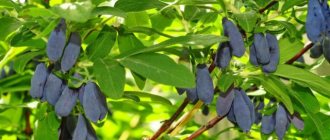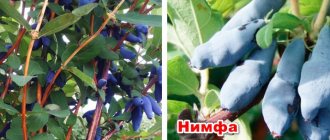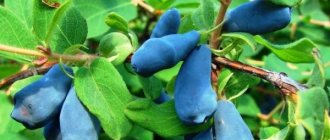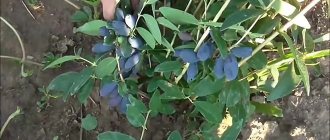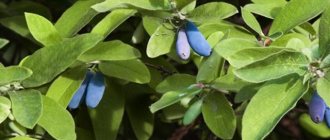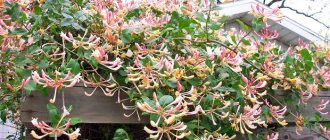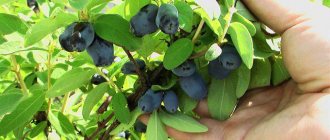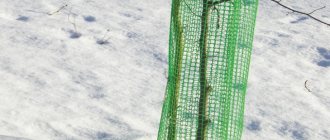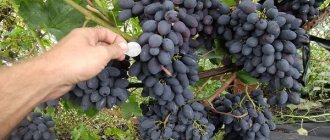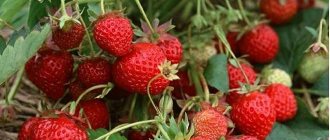What kind of honeysuckle variety is Pavlovskaya?
Pavlovskaya was bred on the basis of the second generation of Kamchatka honeysuckle hybrids in the city of Pavlovsk at the All-Russian Institute of Plant Growing and included in the State Register of Fruit Plants in 2000. The Latin name is lonicera Caerulea Pavlovskaya. Authors - a group of scientists: Plekhanova M. N., Teterev F. K., Koroleva Z. A.
Honeysuckle Pavlovskaya has become widespread in areas with a temperate climate, in particular in the northwestern regions of Russia.
Characteristics and description of bushes
The Pavlovskaya variety has all the characteristic features of the species. This is a medium-sized shrub, obverse-conical in shape with straight thick branches. The leaves are oval, light green. Young branches are densely covered with leaves, but become bare with age. The bark is light brown and may peel off in strips. The height of an adult plant is up to 2 m, the diameter is up to 3 m. The bush begins to bear fruit at 3-4 years of age.
Interesting! Thanks to its dense, compact crown with a rigid skeleton of branches, honeysuckle is used as a difficult green hedge.
The shrub lives and bears fruit in one place for up to 30 years.
Honeysuckle flowers are usually paired, located in leaf axils, irregularly shaped like a funnel, yellowish or pinkish in color. The bush blooms in April – May.
Honeysuckle Pavlovskaya is an excellent honey plant.
Temperature resistance
Hybrid Pavlovskaya is a winter-hardy variety that can withstand temperatures below 30°C and does not require winter shelter. This is a very attractive quality for gardeners in the northern regions.
Honeysuckle flowers are not afraid of return frosts and can withstand temperatures below 0°C.
Attention! In areas with harsh winters, the bush is insulated by wrapping it in non-woven material.
The Pavlovskaya variety easily tolerates sun and high temperatures and prefers to grow in sunny places.
Moisture and drought resistance
Pavlovskaya honeysuckle can withstand long periods of drought. However, when the berries ripen, the plant must receive sufficient moisture, otherwise they will become bitter. Water the bushes with settled or rainwater.
Honeysuckle bushes should grow on well-drained soil, 1 m above the groundwater depth, since they do not tolerate stagnant water. In this case, the root system rots and the plant dies.
Resistance to diseases and pests
One of the indisputable advantages of the Pavlovskaya variety is its high resistance to diseases and pests. However, if the plant is weak or weather conditions are unfavorable, diseases and insect attacks are possible.
In wet and cool summers, honeysuckle is affected by powdery mildew. In this case, the bushes and the soil under them need to be sprayed with fungicidal preparations “Topaz”, “Skor”, “Horus”.
In unfavorable years, the plant is attacked by the following pests:
- Aphids feed on the sap of young shoots and cluster on the tops of branches. This insect is in symbiosis with ants that settle next to the bush. Against aphids, they are treated with bitter solutions of wormwood, garlic, pepper, or the bushes are sprayed with insecticides (Iskra, etc.).
- Red spider mite - its size is 0.2 mm, it is almost invisible to the naked eye. On the back of the leaves you can see a thin web. The mite feeds on the sap of the leaves, causing the leaves to become covered with small yellow or brown spots. The bush is sprayed with a solution of laundry soap or treated with the insecticide “Aktofit”, “Envidor”, “Koragen”.
Periodically inspect the bushes and treat them promptly if pests are detected.
Important! If the plant is strong and the planting site is chosen correctly, Pavlovskaya honeysuckle practically does not get sick.
Diseases and pests
Despite the fact that Zvezdochka honeysuckle is highly resistant to many diseases and is rarely affected by pests, problems may arise if cultivation practices are violated and adverse weather conditions prevail. Sucking harmful insects (mites, aphids, scale insects) can be noticed by the yellowing of the leaves, as well as its deformation. When a spider mite appears on the bushes, a thin web appears.
Damage by pests belonging to the leaf beetle family (leaf roller, leaf miner, Persian moth, sawfly and bugs) can be noticed by holes in the foliage, as well as their curling into a tube. Fingerwings infect honeysuckle berries: they become wrinkled and begin to fall off. To eliminate pests, gardening specialists use chemicals (“Chlorofos”, “Karbofos”), but only after picking the berries. For prevention, such agents are used in autumn and early spring.
Did you know? Scientists have counted about 240 species of honeysuckle. In Russia, 14 of them grow in the wild. Only some of them can be eaten.
During the fruiting period, to repel pests, it is better to use folk remedies - an infusion of onions, garlic or tobacco dust. To prevent the larvae from overwintering, it is recommended to loosen and dig up the soil around the bushes. When rainy and cool weather sets in, fungal diseases may appear. They can be detected by spots and coating on leaves and shoots. To combat fungal diseases, chemical preparations “Topaz”, “Fundazol”, copper sulfate or Bordeaux mixture are used.
In early spring and late autumn, preventive treatments with Bordeaux mixture are carried out against these diseases. As a preventive measure, you should also ensure that the bushes are not too thick and remove weeds and fallen leaves in the fall. The most dangerous diseases for this shrub are viral diseases, since there are no effective drugs to eliminate them. The variegated color of the leaves will indicate that the bush is infected with a virus.
Learn how to deal with honeysuckle pests and diseases.
Infection often occurs from insect pests or when purchasing low-quality seedlings for planting. At the first signs of disease, the bushes should be dug up and burned so that neighboring plant crops are not infected with the virus.
Honeysuckle Zvezdochka attracts attention with its large fruit, stable yields, winter hardiness and unpretentiousness. In addition, this variety is self-pollinating
Caring for it is common for the culture and is simple.
Characteristics and description of fruits
Honeysuckle is valued for its delicious sweet and sour taste. The berries of the Pavlovskaya variety are sweet with sourness and a slight bitterness. The fruits are large, oblong, up to 3 cm long and weighing up to 1.6 g, colored blue with a waxy coating.
The yield of an adult bush reaches 4 kg. This is a medium-ripening variety; the berries ripen at the end of June.
Attention! It is believed that the more pronounced the sour taste, the healthier the berry!
Scope of their application
Honeysuckle fruits are used as food:
- fresh;
- Juices, jams, compotes, and pie fillings are prepared from them;
- make wine;
- frozen for future use.
In folk medicine, berries are used fresh and in the form of alcohol tinctures for the following pathologies:
- hypertension;
- stomach and duodenal ulcers;
- diseases of the kidneys and genitourinary system.
Honeysuckle plays only a supporting role in complex therapy.
History of selection
It is also necessary to mention the history of selection of this crop. Its beginning dates back to the era of the USSR; it was during that period that the cultivation of honeysuckle, which is suitable for human consumption, began. Selection began at the Pavlovsk experimental station under the leadership of the brilliant scientist N.I. Vavilov, which resulted in the selection of more than 90 species of these plants. The Princess variety was bred by scientists from the Institute named after I.V. Michurin. Specialized fields were located in the north of Russia, in the East, and also in Altai. Only the best honeysuckle specimens were selected here.
Important! Only honeysuckle fruits colored dark blue or light blue are edible; shrubs with orange or red berries are considered poisonous.
Advantages and disadvantages of the variety
Honeysuckle variety Pavlovskaya was created for cultivation in mid-latitudes and has a number of undeniable advantages:
- high frost resistance and drought resistance;
- with proper care, the plant practically does not get sick;
- undemanding to soil;
- the fruits are large and have excellent taste;
- low shedding of berries from the bush when ripe;
- the berries tolerate transportation well;
- grows and bears fruit in one place for a long time;
- The bush is decorative and does not require supports.
Disadvantages:
- does not tolerate excess moisture in the soil;
- requires “neighbors”, honeysuckle of other varieties for cross-pollination (Blue Bird, Tomichka) - the berries will be tastier and larger.
Harvesting and transportation (shelf life), shelf life of berries
Harvest honeysuckle in plastic boxes or containers. Each container should weigh no more than 1 kg. If you place a large number of berries in them, they may choke. The Velvet variety is suitable for long-distance transportation if containers are filled correctly.
The shelf life of berries depends on storage conditions. If you place the products in a dark, cool place (basement, attic or balcony), the shelf life will be 1-1.5 months. Berries can be stored in the refrigerator for no more than 3 weeks. To increase shelf life, fruits are prepared at home or frozen in plastic bags.
Delicious honeysuckle berries are known for their beneficial properties. Therefore, many summer residents try to grow this crop on their plots, and succeed in this. Planting and caring for the Velvet variety is simple and does not require much physical or time investment.
Growing technology
The agricultural technology for growing the Pavlovskaya variety is simple, since the plant is resistant to external factors.
Optimal conditions
For successful growth and development of the shrub, choose a sunny place. The sun should illuminate the plant all day and at any time of the year. The landing site is on a small hill to avoid stagnation of groundwater. The location of the bushes should not be heavily blown. This is associated with the risk of frostbite on branches in winter.
Landing dates and rules
The timing of planting is determined by the quality of the seedling. If the root system is open, it is better to plant the plant in spring (April) or early autumn. At this time, the air temperature is moderately warm and it is easier for the plant to adapt. With a closed root system (plant in a container), it is planted in the ground at any time during the warm season.
Work progress:
- Dig a hole the size of which exceeds the volume of the root system by 5 cm.
- A layer of drainage (expanded clay, broken brick, thick branches) is placed at the bottom of the pit.
- Add organic fertilizers (rotted manure, compost, ash) to the pit. This will allow you not to apply fertilizer to the bush for the next 3 years. When adding fertilizer to the pit, do not use fresh manure. The roots will get burned.
- Water the hole thoroughly.
- Place the seedling in it, straighten the roots, cover it with soil, and compact the soil around the trunk with your feet. Do not deepen the neck more than 3 cm.
- Water the planted plant thoroughly.
Further care
After planting honeysuckle Pavlovskaya in dry weather, water the plant at least once a week and do not allow the tree trunk to dry out.
The ground under the bushes is weeded and mulched with dry grass and tree bark. This will get rid of weeds and provide optimal moisture in the root zone.
2-3 years after planting, honeysuckle bushes are fed with complex fertilizers 2-3 times per season.
Wintering
If frosts in your region do not fall below 30°C, then the bush does not require shelter for the winter. However, the tree trunk circle is mulched for the winter, since the superficial root system of honeysuckle can become frostbitten.
If winters are cold and windy, it is worth insulating the plant by wrapping the bush with non-woven material.
Reproduction
Honeysuckle variety Pavlovskaya is propagated in three ways:
- By cuttings. They are taken in the spring from an adult plant before the buds open and placed in a nutrient substrate or wet sand until the roots appear.
- Seeds. Overripe berries are kneaded and spread on a paper napkin. Place in nutrient soil to a depth of 5 mm. When the plant has sprouted and three leaves have appeared, it is planted in open ground.
- By layering. The side branch of the bush is bent to the ground, pressed with a bracket or stone and covered with soil. Over the course of a season, the branch located in the ground will take root. She is separated and placed in a new place.
Honeysuckle Pavlovskaya: variety description, photos and reviews
The external description of the Pavlovskaya honeysuckle variety is practically no different from other species, but has its own characteristic features when grown. The variety was developed thanks to the works of the famous Soviet scientist involved in the selection of berry and fruit crops, Maria Nikolaevna Plekhanova. The woman distributed the hybrids of the resulting varieties throughout Europe. Honeysuckle Pavlovskaya actually has a different name - Viola. Since it was bred in the Pavlovsk nursery, it was nicknamed in honor of the place where the variety was born.
Honeysuckle Pavlovskaya is resistant to drought and frost
Description of honeysuckle Pavlovskaya
The berry gets its name "Viola" because of its purple color. The honeysuckle bush itself grows no more than 2 meters in height, but grows in diameter up to 3 meters. The crown of the bush has an oval shape, as well as erect, dense and powerful branches.
Honeysuckle Pavlovskaya has large and smooth leaves of a rich dark green color on the front side and bluish-gray leaves along the veins on the back.
Large fruits weighing just over 1 gram have a slightly bumpy surface. The shape of the berries is similar to elongated bags with dense blue-violet skin. On the surface of the peel there is a waxy coating characteristic of any type of honeysuckle. The berries have dense pulp. Honeysuckle Pavlovskaya is sweet with a sour taste, slightly bitter.
Planting and caring for Pavlovskaya honeysuckle
The yield of the bush depends on proper planting and care. Therefore, the most important thing when growing a plant is to take timely care measures. Honeysuckle Pavlovskaya was bred specifically for cultivation in mid-latitudes, and therefore has high frost resistance. The bush rarely gets sick and suffers from pests, so it is not particularly difficult to care for. However, in its absence, problems may arise in growing even the most resistant bush with high immunity.
Planting dates for honeysuckle variety Pavlovskaya
Experienced agronomists advise planting honeysuckle in open ground in early spring, around the end of March or early April. The planting period depends on whether the soil on the site has had time to warm up under the first rays of the sun.
Selection and preparation of a landing site
An open area for planting is chosen to allow the sun to fully illuminate the honeysuckle bush at any time of the year. The place should be one meter above groundwater to prevent moisture from stagnating in the ground. Therefore, it is worth choosing slightly elevated areas, avoiding low-lying areas.
The planting site must be chosen where there is a lot of sunlight.
Before planting seedlings in the ground, it is necessary to dig out and carefully level the ground. After this, moisten the soil and apply fertilizer, preferably organic matter.
Landing rules
Holes for planting are dug based on the diameter of the roots. The holes should be 3-4 centimeters larger than the width and length of the straightened roots. The distance between bushes is left from 1 to 1.5 meters.
Honeysuckle is planted in the prepared holes, after carefully straightening the roots. Holding it by the main trunk, they fill it around not with ordinary soil, but with a pre-prepared soil mixture. This nutrient substrate is prepared from:
- loose turf soil;
- humus;
- compost;
- rotted manure;
- wood ash.
The root collar is left at a depth of no more than a centimeter under the ground. The soil around the trunk is not compacted too much. Now you can water the bush with soft water and mulch the top with some dry material: sawdust, peat, leaves.
Watering and fertilizing
Pavlovskaya honeysuckle is very moisture-loving, so the soil under the bush should not be allowed to dry out. However, frequent watering can lead to stagnation of water in the ground, which provokes the appearance of fungal diseases and mold. Therefore, after each watering, you need to loosen the soil by 3-5 centimeters or mulch to retain moisture and reduce watering.
After watering, it is necessary to loosen the soil under the bush
Even with regular watering and loosening the soil, problems or illnesses can arise. This occurs due to watering the bush with cold tap water. It is necessary to let the liquid settle for about 4-5 hours in a wide container, or use melt or rain water.
Honeysuckle Pavlovskaya grows well even with infrequent feeding. But for healthier growth, it is still worthwhile to regularly feed the shrub with organic and mineral fertilizers, which can be purchased in ready-made complex form in special stores. It is recommended to use humus, compost, rotted manure and peat as organic matter.
Pruning edible honeysuckle variety Pavlovskaya
Pruning is especially necessary in the first 8 years of honeysuckle's life. In parallel with sanitary pruning, rotten and dried branches are also removed. After 8-9 years, traditional pruning is stopped and the crown is thinned out only occasionally, cutting off old woody shoots.
When the bush reaches approximately 20-25 years of age, the main or skeletal branches of honeysuckle are removed. This procedure is carried out to renew the bush. Already a year after such a rejuvenation procedure, Pavlovskaya honeysuckle is able to bear fruit. After such pruning, the bush can bear fruit for another 7-9 years, it all depends on the quality of care.
Wintering
In southern latitudes, frost-resistant Pavlovskaya honeysuckle need not be covered for the winter, but in more severe areas it is recommended to protect the bushes for the winter. Often birds, mice and other animals can damage the plant bark in winter. Therefore, all shoots of the bush are carefully twisted with wire and wrapped on top with a fine mesh and protective material.
For wintering, the plant is pulled together and wrapped in protective material.
Reproduction
An adult Pavlovskaya honeysuckle bush can be propagated:
Cuttings are separated from an adult plant. The procedure is carried out in the spring before the buds appear. The cutting can be planted immediately in a moistened soil mixture or kept in a special saline solution until it takes root.
To propagate honeysuckle by seeds, you need to take an overripe fruit and smear it on the surface of a paper napkin. The seeds are planted in a special moistened and loose substrate to a depth of at least 5 millimeters. When the seedlings have more than 3 leaf blades, they can be transplanted into open ground.
The fastest and easiest way to propagate Pavlovskaya honeysuckle is with the help of layering. Lateral adult shoots are bent to pre-dug and fertilized soil and secured in this position. Sprinkle earth on top. The next year, when the cuttings are completely rooted, they are separated from the main bush and, if necessary, transplanted to another place.
Pollinators of honeysuckle Pavlovskaya
To obtain a rich and high-quality harvest, the pollination necessary for flowers must occur during flowering. To do this, next to this variety it is necessary to plant another type of honeysuckle. When choosing it, you need to pay attention to the flowering dates, they should coincide as much as possible.
The most effective pollinating varieties for Pavlovskaya honeysuckle are considered to be “Tomichka”, “Blue Spindle” and “Blue Bird”.
Diseases and pests
Honeysuckle Pavlovskaya is resistant to diseases and pests, but in rare cases it can get sick. Most often this happens due to improper care. Diseases are practically not terrible for the bush, except that an infectious fungus or root rot may appear. Without treatment, it becomes impossible to correct the problem and you will have to completely get rid of the bush so as not to infect the rest.
Among the pests of Pavlovskaya honeysuckle are:
- aphids;
- striped sawfly;
- false shield;
- honeysuckle mite;
- leaf roller
Diseases and pests can seriously harm Pavlovskaya honeysuckle
To combat pests, the bush is treated with special preparations - insecticides.
Conclusion
The description of the Pavlovskaya honeysuckle variety gives a complete picture of this disease- and frost-resistant variety. The berry is characterized by high yield and early ripening. From one adult bush you can collect more than 4 kilograms of fruit. Therefore, in order to obtain such high yields, it is necessary to provide the plant with good and proper care. It is necessary to skillfully select a site for planting, ensure timely watering and fertilizing.
Reviews of honeysuckle Pavlovskaya
Cherepanova Angelina, 45 years old, Arkhangelsk.
Features of growing this variety depending on the region
Honeysuckle Pavlovskaya is ideal for mid-latitudes with a temperate climate. She is known in Europe, Belarus and Ukraine. Based on the properties inherent in the variety, it is grown everywhere except the far north, deserts and areas with high humidity.
The chemical composition of the fruit depends on the growing region. Thus, in berries ripened in the temperate zone, the content of sugar, acids, and vitamin C is higher than in honeysuckle grown in Altai or Primorye.
Reviews from gardeners
Most gardeners leave positive reviews about Pavlovskaya honeysuckle.
Irina, Kaliningrad: “I purchased this variety 5 years ago. I made a special trip to the nursery. I’m very pleased, the plant is not fussy to care for, but it produces such high yields. The berries are not small, which is good.”
Ksenia, Ufa: “A neighbor helped with the propagation of the bush and took a cutting from her. I thought it wouldn’t take root, but it took root surprisingly quickly. Then there were concerns after transplanting it into open ground. But even here the sprout quickly took root. Now, after 4 years, I’m consistently getting a good harvest of sweet and sour berries.”
Angelina, Arkhangelsk: “I bought Pavlovskaya honeysuckle from a photo, at random. I really liked the variety. Maintenance does not require much time or hassle. The main thing is to carry out watering, fertilizing and pruning on time. I was also pleased that the bush is not attacked by pests, and the plant does not become seriously ill.”
Agricultural technology
Edible honeysuckle is a good honey plant. After planting, for three or four years, the bush grows slowly. Caring for it during this period consists of mulching the soil, watering and clearing the soil of weeds. Work on weeding and loosening the soil must be carried out very carefully, because its root system is located close to the surface.
Important! If honeysuckle lacks moisture during fruit ripening, the pleasant sweet and sour taste of the berries will change and become bitter.
Selecting a location
To obtain a large annual harvest, it is recommended to plant the shrub in a well-lit place. In partial shade, honeysuckle will also form berries, but fruiting will become much weaker, or even minimal.
Honeysuckle exhibits considerable tolerance to the type of soil in which it grows. The most suitable habitat for the culture is a substrate with a slightly acidic pH (5.5–6.5). The shrub does not require fertile soil; a sandy-clay substrate is quite suitable for cultivation. It must be taken into account that the crop cannot grow on swampy or constantly wet soils.
Planting and care
If you plan to harvest honeysuckle manually, then when planting you should use a distance of 1–1.5 m between seedlings, as well as a row spacing of 2.5–3 m. In the case of planned mechanical harvesting of berries, the bushes are grown at a distance of 0.6–0. 7 m between plants, and with an interval between rows of 4 to 4.2 m. It is recommended to keep the tree trunk area clear of excess vegetation, so regular weeding is necessary. It is recommended to keep the tree trunk area clear of excess vegetation, so regular weeding is necessary. The presence of perennial weeds such as bindweed, wheatgrass or dandelion in this space is especially unacceptable.
Mulching bushes has a positive effect on their development. To create a layer of mulch, it is best to use crushed bark, peat, wood shavings or black agrofibre, spunbond. This agricultural technique will protect the soil under the bush from the appearance of weeds that suppress them. Such a cover will also prevent excessive drying of the soil, as it prevents moisture evaporation.
Pavlovskaya is resistant to short and long dry periods. The gardener should carry out regular watering only if he is growing young seedlings or potted bushes in the nursery, as well as when honeysuckle is planted in a permanent place in the summer. Another important period in which it is worth watering the bush more often is the phase of flowering and fruit formation. For irrigation, it is best to collect rainwater.
The fertilizer placed in the planting hole will be sufficient for the young plant for the next three years. Next, the organic matter is annually placed by the gardener under the bush and mixed with the top layer of soil (when digging). For adult honeysuckle, 5-6 kg of organic matter (manure, humus) is enough. You can also use mineral fertilizers containing nitrogen for these purposes.
Chemicals intended for one summer season are divided into equal parts and applied in three doses: the first dose - before the beginning of the growing season, the next - at the end of flowering, and the last - before the start of fruiting. These mixtures are purchased in garden stores under the label “For berry bushes.”
Did you know? Often gardeners place a row of honeysuckle bushes along the edge of the garden plot, using the crop as a hedge. The branches of mature shrubs acquire the necessary rigidity and elasticity, which makes such a fence impassable for people and animals.
Planting honeysuckle consists of a sequence of actions:
- Choosing the time of planting - for plants with an open root system, this procedure can be carried out both in the spring and at the end of the warm season. Experienced gardeners are inclined to believe that the second option will be more successful, since not hot and humid autumn weather contributes to the rapid rooting of the shrub. If the purchased seedling grows in a pot, then it can be planted (by transshipment method) at any time convenient for the grower, for example, in the middle of summer.
- Purchasing a seedling - it must be well developed and have healthy roots, consisting of 2-3 thick shoots and many thin ones. On the above-ground part, the presence of 3-4 young shoots is desirable. The health of all parts of the young plant is important, as well as the complete absence of signs of fungal and bacterial diseases on them. It is advisable to buy planting material from specialized berry nurseries; such manufacturers guarantee the health and quality of the shrubs sold.
- Fertilizer - obtaining nutrients from the substrate is very important for any plants, so organic substances rich in nitrogen are placed in the root recess. To do this, you can use pet manure, humus or compost, since all these substances will decompose in the soil for a long time, thereby enriching it and feeding the roots of honeysuckle.
- The hole is dug after choosing a suitable location, and the recommended depth and width of the hole is up to 40 cm. It is advisable to place drainage from thick branches at the bottom, this will help avoid stagnation of water near the roots.
- Planting - the bush is placed horizontally in the center of the planting hole and the roots are evenly spread, after which the hole is filled with soil. Next, the soil is compacted, simultaneously creating a small bowl-shaped slope in the tree trunk zone, which is important for the convenience of future watering. For 2 months, the seedling is watered weekly (with the exception of rainy periods), using at least 5 liters of water at a time.
Features of pollination
To increase productivity, the grower should plant two types of honeysuckle in the garden - in this case, cross-pollination will occur, making the berries tastier and larger. The most successful varieties as pollinators for Pavlovskaya are Blue Spindle, Blue Bird and Tomichka.
Disease and pest control
Honeysuckle Pavlovskaya is very resistant to pests and diseases, but in unfavorable years it can still be affected. During the initial attacks of parasites, it is recommended to try to do without chemicals. You can manually remove leaves and branches from the bush that are infected with aphids or spider mites, wash off the pests using a powerful stream of water from a spray bottle, and treat the plantings with a bitter herbal infusion (wormwood, pepper or garlic). If fungal diseases occur, it is useless to use natural remedies; it is necessary to immediately treat with fungicides.
